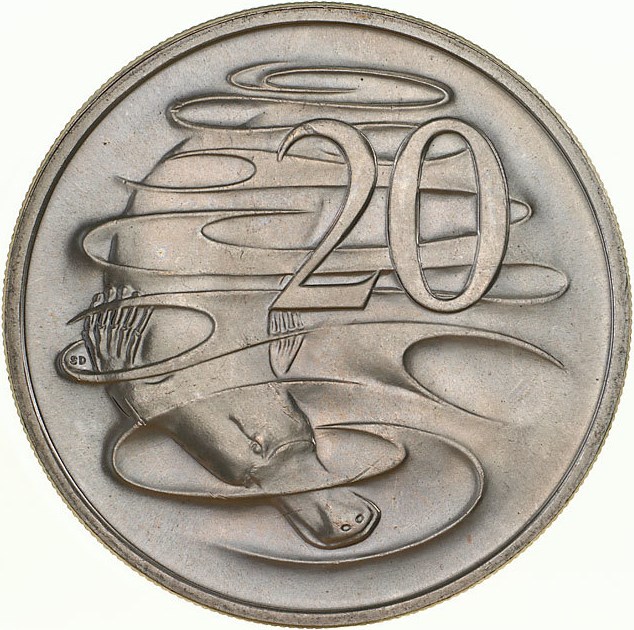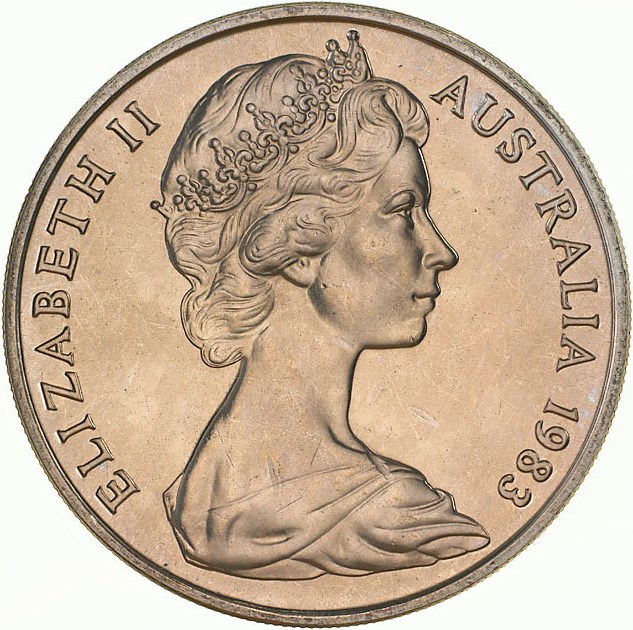Australian 20c pieces 1983-1993
The mintage of Australian 20c pieces in 1981 and 1982 was extremely high - 265,503,000 alone in 1981 (p122, McDonald, Pocket Guide to Australian Coins and Banknotes, 2013) - a figure still unrivalled in 2017. Unsurprisingly, there was no need for new circulating 20c pieces until 1994, though records show that in multiple years from 1983 to 1993 the Royal Australian Mint produced 20c pieces which never ended up in circulation.

While the reported mintage of 1983 and 1984 20c pieces is reasonably high (55,113,000 and 27,820,000 respectively) it is unlikely that any were ever released into circulation. Reportedly "almost the entire production was later melted down and exported as base metal cupro-nickel bars when there was no economic demand for them through the Reserve Bank" (p122, McDonald, Pocket Guide to Australian Coins and Banknotes, 2013). One $200 mint roll box of each year has been reported (p122, McDonald, Pocket Guide to Australian Coins and Banknotes, 2013) though the circumstances in which these boxes were found remains unclear. The author has been unable to find an example of either coin in change and other collectors have reported similar difficulty in finding circulating examples.
The reported mintage of 1985 20c pieces is reasonably low - just 2,700,000 (Royal Australian Mint, https://www.ramint.gov.au/twenty-cents) - but not low enough to be impossible to find: the author has been unable to find an example in change however and other collectors report similar difficulty in finding a circulating example. It is possible that the reported mintage was actually part of the 1984 mintage and hence there are likely no circulating 1985 20c pieces. Any pieces found in change are likely to be from broken mint sets.

No 20c pieces dated 1986 or 1987 are reported to have been struck or released for circulation though both were struck for mint and proof sets.
The Royal Australian Mint reports that 200,000 1988 20c pieces were struck for circulation (Royal Australian Mint, https://www.ramint.gov.au/twenty-cents), though the Pocket Guide to Australian Coins and Banknotes reports a mintage of 174,000 (p124, McDonald, Pocket Guide to Australian Coins and Banknotes, 2013). Regardless of which figure is correct it is the lowest reported mintage of any Australian decimal circulating coin, but, once again, it should not be impossible to locate an example in change. Similar to the the 1985 20c piece the author never seen an example in circulation and other collectors have reported similar results. McDonald agrees that "It is generally thought that coins of this date can only be found in Mint and Proof sets" (p124, McDonald, Pocket Guide to Australian Coins and Banknotes, 2013). It is also possible that the the small number of 1988 20c pieces that were produced but later melted down.
No 20c pieces dated 1989, 1990, 1991 or 1992 are reported to have been struck or released for circulation though each were struck for mint and proof sets.
Older catalogues report 1,498,500 circulating 1993 20c pieces as having been struck (p95, McDonald, The Pocket Guide to Australian Coins and Banknotes, 2003) though subsequent editions clarify that "the 1993-1994 Annual Report shows that 1,498,500 coins with pre-1987 dates were issued into circulation from previously coins already in store at the RAM" (p124, McDonald, Pocket Guide to Australian Coins and Banknotes, 2013). Presumably the coins released in 1993 were dated 1981 or 1982 (or perhaps even earlier) as no 20c pieces dated 1983 to 1986 appear to have ever reached circulation. No circulating coins being struck in 1993 also matches both the author's and other collectors' inability to find an example in change.
Note: the above anecdotal evidence is based on 19 years (1999 to 2018) of the author searching change in Australia.
Images provided by Museum Victoria under Creative Commons Attribution 4.0 International